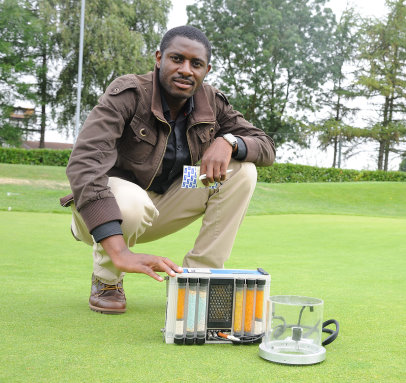
Greenkeepers could manage stress in turf plants more effectively with well-timed applications of Primo Maxx growth regulator and Heritage Maxx fungicide, according to initial indications of a Harper Adams University College research project being undertaken by PhD student Harry Mbah.
Demonstrating the effects of treatments at the Turf Science Live event, organised by Syngenta and Everris (formerly known as Scotts) at The Belfry in the West Midlands, Mr Mbah revealed differences in photosynthetic activity and turf colour that could be associated with reduced stress and enhanced plant health.
Harper Adams turf specialist, Dr John Reade, reported the project is giving a valuable insight into the reaction of turf plants to stress.
“Excitingly we are looking to see what is going in the plant before we get to a situation where it is visibly suffering from the effects of stress,” he said. “That could give greenkeepers and agronomist the chance to act and alleviate stress. In an ideal world we would remove the stress factor, such as irrigating or feeding the plant. However, in practice there are many factors involved and it may be that timely applications of Primo Maxx or Heritage Maxx may be a viable route to maintain plant health and turf quality.”
The project studies include looking at plant cell membrane stability as a technique to measure stress and the effects of treatments. Gas exchange monitors can also assess photosynthetic activity and the potential for infra-red spectrometry assessment chlorophyll levels.
Furthermore, Mr Mbah is also undertaking further research with greenkeepers, to look at the primary causes of stress in practical golf course management, along with looking at the implications for playability and the delivery of high quality surfaces.

“Our intention is to find answers that fit with practical solutions,” reported Dr Reade. “We also have to look at the role of different grass species and even varieties. Working at a scientific research level is throwing up some fascinating insights, but being able to apply them at a practical level could provide valuable answers.”
Dr Reade highlighted that it cannot naturally be assumed that all fungicides will have the same effect. Whilst they may all have an effect for disease control, the way they achieve it and the beneficial side effects on plant health may all be different, he added.
Mr Mbah’s research into the role of Primo Maxx will also entail detailed evaluation of the implications of the greater root mass in helping plants cope with stressful conditions, for example, as well as assessing the levels of different chlorophyll types in the leaf and the effects on colour.
Initial results of the scientific studies, sponsored by Syngenta andHarperAdamsUniversityCollege, with support from STRI, will be available by the end of the year and on-going through 2012.
Harper Adams University College www.harper-adams.ac.uk
STRI www.stri.co.uk
Syngenta www.greencast.co.uk

